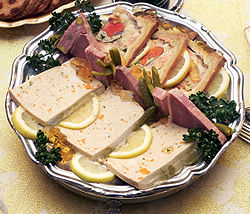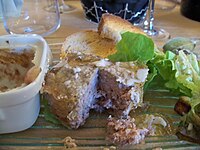Pâté
 Various pâtés | |
| Place of origin | |
|---|---|
| Main ingredients | Meat, fish, seafood, or vegetables |
Pâté (UK: /ˈpæteɪ/ PAT-ay, US: /pɑːˈteɪ, pæˈ-/ pa(h)-TAY, French: [pɑte] ⓘ) is a forcemeat. Originally, the dish was cooked in a pastry case; in more recent times it is more usually cooked without pastry in a terrine. Various ingredients are used, which may include meat from pork, poultry, fish or beef; fat; vegetables; herbs; spices; wine; and brandy.
History and etymology
[edit]Both the Dictionnaire de l'Académie française and the Oxford English Dictionary (OED) date the term back to the 12th century. The former gives the original meaning as a "culinary preparation consisting of minced meat or fish surrounded by dough and baked in the oven";[1] the OED's definition is "a pie or pastry usually filled with finely minced meat, fish, vegetables, etc."[2] The French words pâte (pastry) and pâté are both derived from the Latin pasta meaning paste or dough (as is the English "pastry").[3] By the 19th century the pastry case was often dispensed with.[2] According to Larousse Gastronomique, when there is a pastry case the dish is pâté en croute and when there is not, and the mixture is cooked in a dish (called a terrine), it is pâté en terrine, often abbreviated to terrine or pâté, terms used interchangeably in both French and English usage.[4] A patty is a similar dish, and its name comes from a 19th-century English corruption of the French word pâté.
Pâté was known to the Romans, who generally made it with pork, although other main ingredients might include marinated and spiced birds' tongues.[4] In the Middle Ages, there were numerous recipes for pâtisseries (meats – pork, poultry, game or fish – cooked in pastry).[4]
Tinned pâté, being shelf-stable, has sometimes been included in military rations,[5] for, among others, the French Armed Forces, whose rations have included tinned pâté for more than 100 years.[6]
Varieties
[edit]There are numerous varieties of French pâtés or terrines, including:
| Type and main ingredients | French name | Reference |
|---|---|---|
| calves' sweetbreads terrine | terrine de ris de veau | [7] |
| game pâté | terrine de gibier | [8] |
| duck or goose liver pâté (foie gras) | pâte de foie gras | [9] |
| ham and cauliflower terrine | terrine de jambon et chou-fleur | [10] |
| ham, pork and veal terrine | terrine de jambon, porc et veau | [11] |
| hare terrine | terrine de lièvre | [12] |
| mushroom pâté | pâté de cèpes | [13] |
| partridge terrine | terrine de perdreau | [14] |
| pheasant terrine | terrine de faisan | [14] |
| pigeon terrine | terrine de pigeon | [15] |
| pork and game terrine | terrine de porc et de gibier | [16] |
| pork and liver pâté | terrine de campagne | [17] |
| quail terrine | terrine de caille | [14] |
| rabbit terrine | terrine de lapin | [18] |
| truffled pâte of duck | pâté de canard Lucullus | [19] |
| turbot and salmon terrine with lobster | terrine de l'océan | [14] |
| vegetable terrine | terrine de légumes | [14] |
| venison liver pâté | pâté de foie de chevreuil | [20] |
Parfait
[edit]Chicken liver parfait is a subtype of pâté. Instead of first cooking the livers in butter, for a parfait they are initially pureéd when raw and then passed through a sieve or put in a blender before being mixed with, typically, eggs, fortified wine, shallots, thyme, garlic and cognac and cooked in a bain-marie until set. This allows for a smoother texture.[21]
Other countries
[edit]In former Soviet countries, pâté from liver is very popular and it is commonly known as pashtet (Russian: паштет, "pâté"). Liver from other animals (such as cow) can also be used. The liver is first cooked (boiled or fried) and mixed with butter or fat and seasonings such as fresh or fried onions, carrots, spices, and herbs.[22] It can be further cooked (usually baked), but most often used without any other preparation. In Russia, the pâté is served on a plate or in a bowl, and is typically moulded into the shapes of animals, such as hedgehogs.[23]
In Ashkenazi Jewish cuisine, a similar recipe is known as chopped liver, with schmaltz used instead of butter and hard-boiled eggs frequently added. Another common type of pâté in Jewish cuisine, also popular in Russia and Ukraine, is vorschmack, or gehakte herring (chopped herring).[24] In Vietnamese cuisine, pâté is commonly used on bánh mì baguette-type sandwiches.[25]
-
Wild boar terrine
-
Chopped liver
-
Vorschmack (chopped herring)
-
Polish pasztet
See also
[edit]References
[edit]- ^ "Pâté, nom masculin", Dictionnaire de l'Académie française. Retrieved 7 March 2024
- ^ a b "pâté". Oxford English Dictionary (Online ed.). Oxford University Press. (Subscription or participating institution membership required.)
- ^ Davidson, p. 229
- ^ a b c Beullac, p. 922
- ^ Graham-Harrison, Emma (18 February 2014). "The eat of battle – how the world's armies get fed". The Guardian. Archived from the original on 13 September 2023. Retrieved 6 February 2024.
- ^ Lilley, Zane (17 May 2023). "French reservist sends 22,000 tins of Breton pâté to Ukrainian sailors". The Connexion. Archived from the original on 22 September 2023. Retrieved 6 February 2024.
- ^ Beullac, p. 1254
- ^ David (2010), p. 198
- ^ Brazier, p. 63
- ^ Roux, p. 41
- ^ David (1999 ), p. 506
- ^ David (1999 ), p. 432
- ^ Brazier, p. 85
- ^ a b c d e Beullac, pp. 1294–1295
- ^ David (1999 ), p. 430
- ^ David (2010), p. 199
- ^ David (2010), p. 197
- ^ David (1999 ), p. 429
- ^ David (2010), p. 200
- ^ Brazier, p. 88
- ^ Blanc, Raymond, "Chicken liver parfait", BBC. Retrieved 14 October 2024
- ^ "Pork Liver Pâté – Nomadic Fork pork liver pate low carb". Nomadic Fork. 14 June 2020. Archived from the original on 11 January 2022. Retrieved 11 January 2022.
- ^ Goldstein, p. 33
- ^ В. В. Похлебкин. Национальные кухни наших народов. Москва, изд. Пищевая пром-сть, 1980. Еврейская кухня Archived 31 December 2017 at the Wayback Machine. (William Pokhlyobkin. The Ethnic Cuisines of our Peoples. Moscow, Food Industry publishing house, 1980; Russian)
- ^ "Pork and Pâté Vietnamese Sandwich (Banh Mi)". Archived from the original on 14 February 2015. Retrieved 13 February 2015.
Sources
[edit]- Beullac, Geneviève, ed. (2001). Larousse Gastronomique. London: Hamlyn. ISBN 978-0-60-060235-4.
- Brazier, Eugénie; Moreau, Roger; Bocuse, Paul; Pacaud, Bernard (2015) [2004]. La Mère Brazier: The Mother of Modern French Cooking. London: Modern Books. ISBN 978-1-906761-84-4.
- David, Elizabeth (1999) [1980]. Elizabeth David Classics. London: Grub Street. ISBN 978-1-902304-27-4.
- David, Elizabeth (2010) [1960]. French Provincial Cooking. London: Folio Society. OCLC 809349711.
- Goldstein, Darra (1999). A Taste of Russia: A Cookbook of Russian Hospitality. Russian Information Service. ISBN 978-1-88-010042-4.
- Roux, Michel Jr (2009). A Life in the Kitchen. London: Weidenfeld & Nicolson. ISBN 978-0-297-84482-2.
External links
[edit] The dictionary definition of pâté at Wiktionary
The dictionary definition of pâté at Wiktionary





